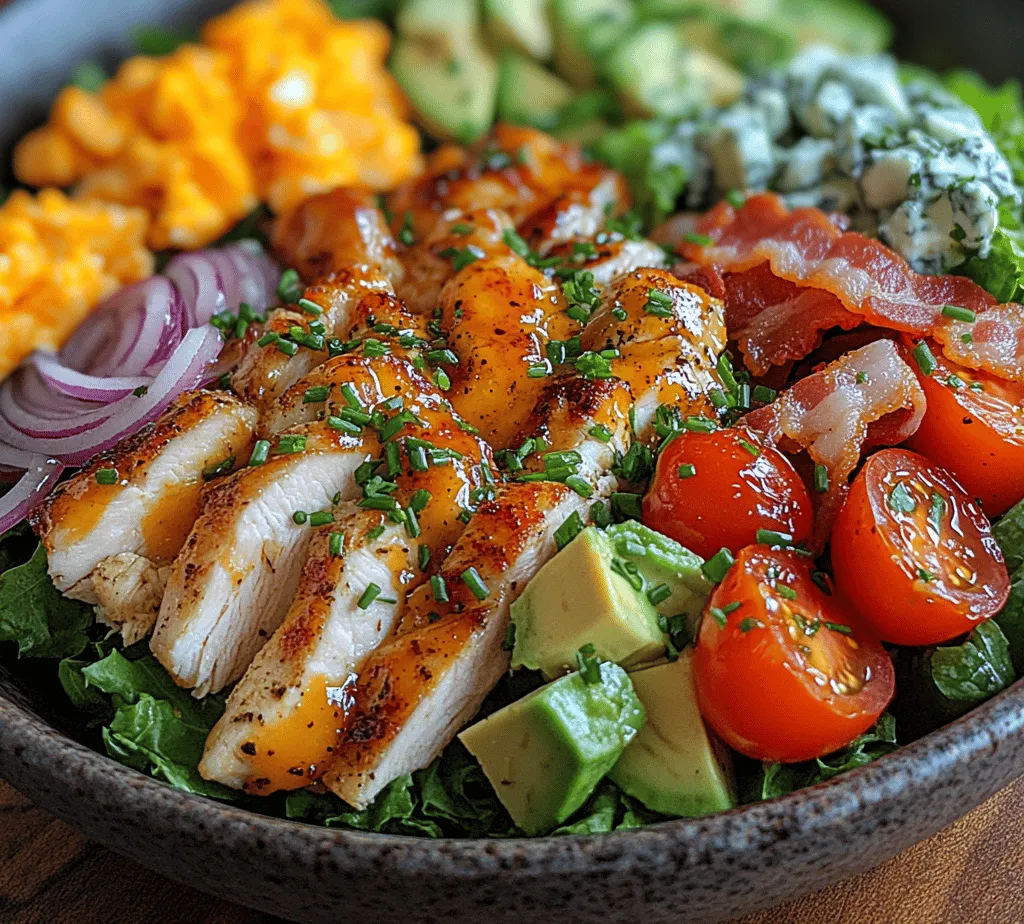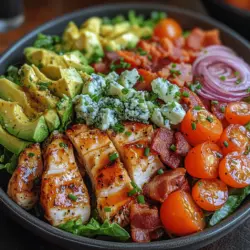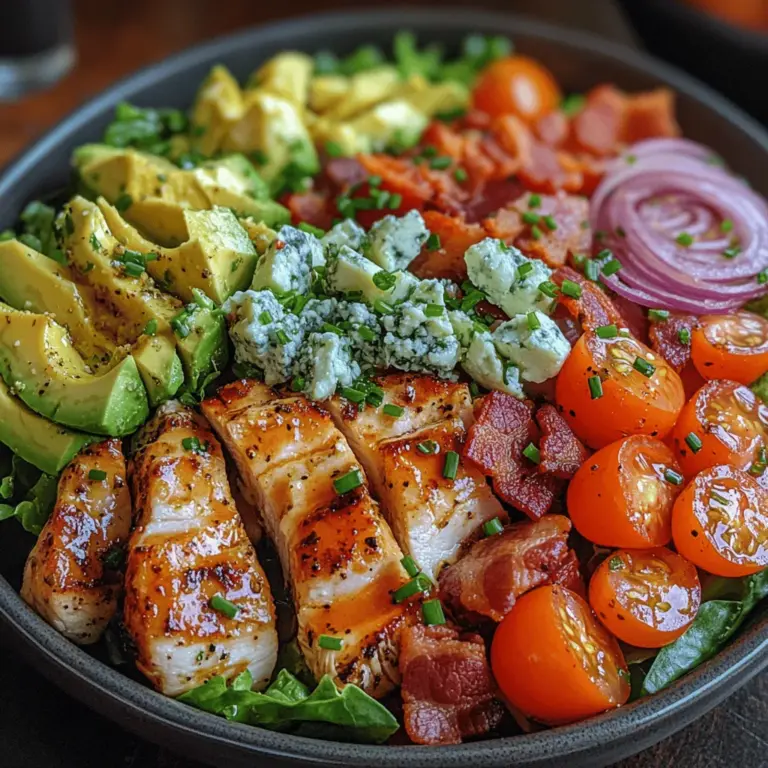Introduction
Cobb salad is a quintessential American dish that marries a variety of flavors, textures, and colors into one hearty meal. Believed to have originated in the 1930s at the Brown Derby restaurant in Hollywood, this salad combines the culinary creativity of its namesake, Robert Cobb, with the fresh ingredients available at the time. The original recipe featured a mix of leftover ingredients from the restaurant’s kitchen, including chicken, bacon, eggs, and greens. Over the decades, it has become a staple on restaurant menus and a favorite among home cooks, celebrated for its versatility and satisfying nature.
The classic Cobb salad has earned a special place in the hearts of many due to its adaptability. It can be served as a casual lunch or dressed up for elegant dinner parties. The vibrant colors and hearty ingredients make it visually appealing, while the combination of flavors—from the smoky bacon to the creamy avocado—creates a delightful and balanced dish. Cobb salads are not only delicious but also nutritious, making them a perfect choice for those seeking a fulfilling meal without sacrificing health.
When it comes to nutritional benefits, the ingredients in a classic Cobb salad are packed with essential vitamins and minerals. The base of romaine lettuce provides dietary fiber and a variety of vitamins, while the cooked chicken breast serves as a lean source of protein, critical for muscle repair and overall health. Bacon adds a savory crunch, hard-boiled eggs contribute healthy fats and protein, and avocado offers potassium and monounsaturated fats that promote heart health. Cherry tomatoes, blue cheese, red onion, and fresh chives enhance the flavor profile and add their own health benefits, creating a well-rounded dish that is both satisfying and nourishing.
Understanding the Ingredients of a Classic Cobb Salad
To create a truly exceptional Cobb salad, it is essential to understand each ingredient’s role and benefits. Below, we break down the components that make up this classic dish.
Romaine Lettuce
The foundation of a Cobb salad is typically romaine lettuce. This leafy green is favored for its crisp texture and slightly bitter flavor, which balances the richness of the other ingredients. Nutritionally, romaine is a powerhouse—it is low in calories and rich in vitamins A, K, and C, as well as folate and fiber. Its sturdy leaves hold up well to dressing, ensuring that each bite is as flavorful as the last.
Cooked Chicken Breast
Chicken breast is the protein star of the Cobb salad. Rich in lean protein, it helps to keep you full and nourished. For optimal flavor and texture, it is best to use grilled or roasted chicken breast, seasoned simply with salt, pepper, and perhaps a touch of garlic or other herbs. Cooking the chicken in advance and slicing it into bite-sized pieces allows for easy assembly of the salad, while adding a warm element that enhances the overall dish.
Bacon
Bacon brings an undeniable savory richness to the Cobb salad. Its crispy texture and smoky flavor complement the other ingredients beautifully. For the best results, cook the bacon until it is golden and crispy, then drain it on paper towels to remove excess grease. This not only makes the bacon less greasy but also ensures it retains its crunch when added to the salad.
Hard-Boiled Eggs
Hard-boiled eggs are another classic component of the Cobb salad, contributing protein and a creamy texture. They are also a great source of vitamins D and B12, as well as choline, which is essential for brain health. To achieve the perfect hard-boiled egg, place eggs in a pot, cover them with cold water, and bring to a boil. Once boiling, cover the pot and turn off the heat, letting the eggs sit for about 9-12 minutes before transferring them to an ice bath. This method not only ensures even cooking but also makes peeling the eggs much easier.
Avocado
Avocado is a game-changer in the Cobb salad, providing a creamy texture and a boost of healthy fats. This fruit is rich in potassium, fiber, and monounsaturated fats, which are known to support heart health. When selecting avocados, look for ones that yield slightly to pressure, indicating ripeness. To prepare, slice the avocado just before serving to prevent browning, and consider adding a squeeze of lemon juice for extra flavor and to keep it fresh.
Cherry Tomatoes
Cherry tomatoes add a burst of sweetness and acidity to the Cobb salad. They are packed with antioxidants, including lycopene, which is associated with various health benefits. When selecting cherry tomatoes, look for ones that are firm and vibrant in color. They can be halved or left whole for added texture, depending on your preference.
Blue Cheese
Blue cheese is a distinctive ingredient that adds a tangy flavor to the Cobb salad. Its creamy texture contrasts beautifully with the crunchy vegetables and crispy bacon. When selecting blue cheese, opt for high-quality varieties that offer a robust flavor. If blue cheese isn’t your preference, consider substituting it with feta or goat cheese for a different but equally delicious taste.
Red Onion
Red onion provides a sharp bite that complements the richness of the other ingredients. It is milder than yellow or white onions, making it a popular choice for salads. Rich in antioxidants and vitamin C, red onions not only enhance the flavor but also contribute to the health benefits of the dish. To mellow their flavor, consider soaking sliced onions in cold water for a few minutes before adding them to the salad.
Fresh Chives
Chives are a delicate herb that can be used as a garnish for the Cobb salad. Their mild onion flavor adds a fresh element to the dish, enhancing the overall taste. Chives are rich in vitamins A and C and can be easily chopped and sprinkled over the salad just before serving for a pop of color and flavor.
Vinaigrette
The dressing is the finishing touch that ties all the ingredients together. While many prefer a classic red wine vinaigrette, you can customize it to your taste. A homemade vinaigrette made with olive oil, vinegar, Dijon mustard, and a touch of honey is simple to prepare and elevates the salad’s flavors. If you’re short on time, a good-quality store-bought vinaigrette can also work well, but be sure to check the ingredient list for added sugars or preservatives.
Step-by-Step Preparation of the Classic Cobb Salad
Now that we’ve covered the ingredients, it’s time to dive into the preparation of the classic Cobb salad. Below are detailed instructions to help you assemble this delicious dish.
1. Prepare the Ingredients: Begin by washing and drying the romaine lettuce thoroughly. Tear the leaves into bite-sized pieces and place them in a large salad bowl as the base of your salad.
2. Cook the Chicken: If you haven’t done so already, season your chicken breast with salt and pepper, then grill or roast it until cooked through. Let it rest for a few minutes before slicing it into strips or cubes.
3. Crisp the Bacon: In a skillet over medium heat, cook the bacon until it’s crispy and browned. This usually takes about 5-7 minutes. Once ready, transfer the bacon to a plate lined with paper towels to drain any excess grease.
4. Hard-Boil the Eggs: Prepare the hard-boiled eggs following the method described above. Once cooked, peel and slice them into quarters or halves.
5. Slice the Avocado: Just before assembling the salad, cut the avocado in half, remove the pit, and carefully scoop it out. Slice the flesh into thin pieces.
6. Prepare the Cherry Tomatoes: If using whole cherry tomatoes, rinse them and slice them in half for easier eating.
7. Assemble the Salad: On top of the bed of romaine lettuce, arrange the sliced chicken, crispy bacon, hard-boiled eggs, avocado, cherry tomatoes, blue cheese, and red onion in rows or sections for a beautiful presentation.
8. Garnish with Chives: Finally, sprinkle chopped fresh chives over the top for a burst of color and flavor.
9. Dress the Salad: Just before serving, drizzle your homemade or store-bought vinaigrette over the salad. Toss gently to combine, ensuring that all ingredients are evenly coated.
By carefully preparing each ingredient and assembling them in a visually appealing way, your classic Cobb salad will not only be delicious but also a feast for the eyes. This hearty meal is perfect for any occasion, whether it’s a sunny picnic, a casual dinner, or a festive gathering with friends and family. Enjoy the delightful combination of flavors and the satisfaction of creating a classic dish that has stood the test of time.

How to Dice and Chop Ingredients Neatly for Even Layering
Creating a visually appealing and delicious Classic Cobb Salad starts with how you prepare your ingredients. Neat dicing and chopping not only contribute to the aesthetics of the dish but also ensure even distribution of flavors with each bite. Here are some essential techniques for chopping ingredients:
1. Chopping Techniques: Use a sharp knife and a stable cutting board. For ingredients like tomatoes, avocados, and cucumbers, slice them into uniform pieces (about ½ inch). This consistency helps in even layering and makes for a more enjoyable eating experience.
2. Dicing Avocado: Cut the avocado in half, remove the pit, and score the flesh with a knife in a grid pattern before scooping it out with a spoon. This method ensures neat cubes that are easy to place in your salad.
3. Chopping Cooked Chicken: If using leftover roasted chicken or grilled chicken, allow it to cool slightly before chopping. This prevents it from shredding and helps maintain the texture. Aim for bite-sized pieces that hold their shape.
4. Uniformity in Ingredients: When preparing ingredients like bacon, cheese, and eggs, chop or slice them to similar sizes as the other salad components. This uniformity not only enhances the salad’s visual appeal but also ensures that each forkful has a balanced taste.
Importance of Ingredient Freshness and Seasonal Variations
Freshness is paramount for a Classic Cobb Salad. Using seasonal ingredients will not only elevate the flavor but also ensure that your salad is packed with nutrients. Here are some tips:
– Seasonal Ingredients: Whenever possible, choose seasonal produce. For example, in spring, you might find fresh peas or radishes to add a crisp texture. In summer, ripe heirloom tomatoes will contribute sweetness and juiciness. Fall might inspire the addition of roasted butternut squash, while winter could lead to the use of hearty greens like kale or spinach.
– Fresh Herbs: Incorporating fresh herbs like parsley, chives, or cilantro can elevate your salad, adding vibrant flavors and colors. Always wash herbs thoroughly and give them a rough chop before adding them to the mix.
– Quality Proteins: Opt for high-quality proteins, whether it’s free-range chicken, organic eggs, or bacon from a trusted source. Fresh ingredients not only taste better but are generally more nutritious.
Assembling Your Classic Cobb Salad
Now that your ingredients are prepped, it’s time to assemble your Classic Cobb Salad. This step is crucial for both flavor layering and visual presentation.
Guidelines for Arranging Ingredients for Visual Appeal
1. Base Layer: Start with a bed of fresh, crisp greens such as romaine or mixed salad greens. This provides a sturdy foundation that holds the other ingredients.
2. Colorful Arrangement: Arrange the ingredients in rows or sections rather than mixing them all together. This allows the vibrant colors of the red tomatoes, yellow corn, green avocado, and white cheese to shine through.
3. Layering Components: Begin with the protein (chicken) and then add the bacon, eggs, and cheese. Finish with the tomatoes and avocado on top. This not only looks beautiful but makes it easy for diners to pick and choose their desired ingredients.
Techniques for Layering Flavors and Textures
1. Contrast of Textures: The key to an enjoyable salad is the combination of textures. The crispiness of bacon contrasts with the creaminess of avocado and the crunch of cucumbers. Aim for a balance that keeps each bite interesting.
2. Drizzle of Dressing: Instead of tossing the salad in dressing, consider drizzling it over the top just before serving. This enhances the visual appeal and allows guests to mix in their desired amount.
3. Final Touches: Don’t forget to sprinkle freshly cracked pepper and a pinch of salt over the assembled salad. These finishing touches can elevate the dish significantly.
Importance of Seasoning and How It Affects the Overall Taste
Seasoning is a critical step in ensuring your Classic Cobb Salad is bursting with flavor. Here’s how to enhance your dish:
– Salt and Pepper: These basic seasonings can bring out the natural flavors of the ingredients. Remember to season each layer as you add it to the salad.
– Dressing Balance: A well-balanced dressing complements the ingredients without overpowering them. A classic vinaigrette made with olive oil, vinegar, Dijon mustard, salt, and pepper works beautifully here. Consider adding a touch of honey or maple syrup for sweetness.
Serving Suggestions for Cobb Salad
The versatility of Cobb Salad allows it to shine both as a main dish and a side. Here are some serving suggestions:
Ideas for Serving Cobb Salad as a Main Dish or Side
– As a Main Dish: Serve the salad in large bowls with crusty bread on the side for a complete meal. The protein content from chicken and eggs makes it hearty enough to stand alone.
– As a Side: For gatherings, serve smaller portions of Cobb Salad alongside grilled meats or sandwiches. This allows guests to enjoy a lighter option while still participating in a hearty meal.
Pairing Suggestions with Beverages or Additional Sides
– Beverage Pairings: A Cobb Salad pairs well with crisp white wines like Sauvignon Blanc or a light beer. For non-alcoholic options, consider iced tea or sparkling water with a slice of lemon.
– Additional Sides: Consider serving your salad with a side of roasted vegetables or a light soup, which can complement the freshness of the salad without overshadowing it.
Presentation Tips to Enhance the Dining Experience
– Plating: Use clear glass bowls or crisp white plates to enhance the colors of the salad. Layering the ingredients in a glass bowl can also add visual interest.
– Garnishes: Fresh herbs or edible flowers can add an elegant touch. Sprinkle some chopped chives or parsley right before serving for an appealing finish.
Nutritional Analysis of the Classic Cobb Salad
Understanding the nutritional benefits of your Classic Cobb Salad can help you make informed choices. Here’s a breakdown:
Breakdown of Calories, Proteins, Fats, and Carbohydrates Per Serving
A typical serving of Classic Cobb Salad contains approximately:
– Calories: 350-450 (depending on portion size and dressing)
– Proteins: 28-35 grams (from chicken, eggs, and cheese)
– Fats: 20-30 grams (from avocado, cheese, and dressing)
– Carbohydrates: 10-15 grams (from vegetables and dressing)
This balance makes Cobb Salad an excellent option for those looking to maintain a nutritious diet.
Discussion of Health Benefits Associated with Each Ingredient
Each component of the Cobb Salad brings unique health benefits:
– Greens: Dark leafy greens provide essential vitamins A, C, and K, along with fiber.
– Avocado: Packed with healthy fats, avocados promote heart health and help absorb fat-soluble vitamins.
– Chicken: A great source of lean protein, chicken supports muscle maintenance and overall health.
– Eggs: Rich in protein and nutrients like choline, eggs are beneficial for brain health.
– Bacon and Cheese: While these add flavor and richness, moderation is key due to higher fat content.
Tips for Making the Salad Even Healthier, Such as Substitutions or Modifications
– Lower Calorie Dressing: Opt for a homemade vinaigrette using yogurt as a base for a creamy texture without the excess calories.
– Vegetarian Option: Substitute chicken with chickpeas or grilled tofu for a plant-based protein.
– Reduced Fat Cheese: Use a lower-fat cheese option or nutritional yeast for a cheesy flavor without the fat.
Variations and Customizations of Cobb Salad
The Classic Cobb Salad is highly customizable, making it suitable for various dietary preferences. Here are some suggestions to mix things up:
Suggestions for Alternative Proteins (e.g., Shrimp, Tofu)
– Seafood Twist: Grilled shrimp can replace chicken for a fresh seafood version.
– Plant-Based Protein: Tofu, tempeh, or seitan can be marinated and grilled for a hearty vegetarian alternative.
Vegetarian and Vegan Adaptations
– Vegetarian Cobb Salad: Remove bacon and chicken, adding roasted chickpeas and extra avocado for richness.
– Vegan Cobb Salad: Use plant-based cheese and omit eggs, incorporating additional ingredients like nuts or seeds for added protein.
Seasonal Ingredient Swaps for Year-Round Enjoyment
– Winter: Swap tomatoes for roasted root vegetables like sweet potatoes or beets.
– Summer: Add fresh corn and bell peppers for a crunchy, sweet flavor.
Conclusion
The Classic Cobb Salad stands out as a timeless dish that perfectly balances flavors and textures while offering numerous health benefits. Its versatility allows it to be enjoyed in a variety of settings—from casual lunches to elegant dinner parties. By personalizing your Cobb Salad with seasonal ingredients, alternative proteins, and creative dressing options, you can cater to your taste preferences and dietary needs.
Now is the perfect time to embrace the classic Cobb Salad. Whether you follow the traditional recipe or explore variations, this salad is sure to become a favorite in your culinary repertoire. Encourage friends and family to join you in creating their own versions, making mealtime a delightful and personalized experience. Enjoy the process, and let your creativity shine through each layer!

